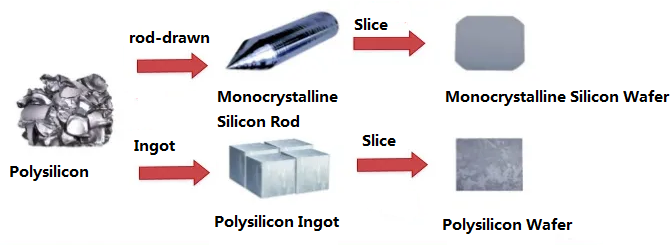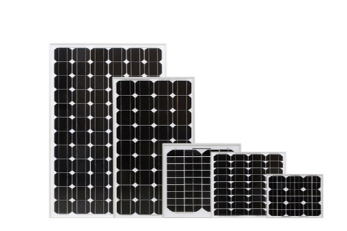The development process of solar cells has mainly gone through three stages:
The first stage is mainly polycrystalline silicon and monocrystalline silicon solar cells.
The second stage is mainly amorphous silicon thin film solar cells and crystalline silicon thin film solar cells.
The third stage is mainly about some new concept solar cells such as perovskite solar cells, quantum dot solar cells, and organic solar cells.
At present, polycrystalline silicon and monocrystalline silicon solar cells occupy 90% of the market. Other solar cells are expensive and are not cost-effective now, but they are the future development direction of solar cells.
Let's take a look at the relevant knowledge of crystalline silicon solar cell modules.
The development of crystalline silicon solar cells, based on high-purity silicon-based materials, is finally divided into polycrystalline silicon and monocrystalline silicon under the action of two different processes.
The silicon-based material undergoes a rod drawing process to become monocrystalline silicon rods, and then sliced to become monocrystalline silicon wafers;
The silicon-based material undergoes an ingot casting process to become a polycrystalline silicon ingot, which is then sliced to become a polycrystalline silicon wafer.

The difference visible to the naked eye is:
The monocrystalline silicon cell is dark blue and rectangular;

The polysilicon cell is light blue and square.
With the cell, the following work is to make the components:
Glue the photovoltaic glass and solar cells together with EVA adhesive film to form a laminate; use a laminator to laminate the laminate into a whole, use silicone/tape to install the laminate into the aluminum frame, and install a junction box; After the silicone is cured, a photovoltaic module is formed.
No. 1 in the world
Manufacturing photovoltaic modules is as simple as that in the early days!
In China's early photovoltaic development, solar cells were imported from abroad, processed by a sealing process, and then sold. In that era, 90% of core raw materials and equipment were imported from abroad; after simply assembled into components, 90% were exported abroad.
Unfortunately, the 2008 financial crisis led to a sharp drop in subsidies for new energy sources in Western countries. Coupled with anti-dumping duties, it suddenly pierced the Chinese photovoltaic bubble and a large number of companies went bankrupt, causing a devastating blow to the industry.
After learning from the painful experience, China's photovoltaic companies have begun to increase technological research, and the state has also introduced subsidy policies in due course, opening up the domestic energy transition, and photovoltaics have gained an opportunity to take off.
After more than 10 years of development, China's photovoltaic industry has become the most competitive industry, leaving European and American countries far behind.
In 2017, the scale of China's photovoltaic industries accounted for more than 50% of the global total, establishing a global competitive advantage.
Today, TOP 4 global silicon material companies, TOP 7 silicon wafer companies, TOP 4 solar cell companies, and TOP 5 component companies—all are Chinese companies.
China's annual new photovoltaic installed capacity and total installed capacity have ranked first in the world for many years.
Distributed photovoltaic power station
Let's talk about photovoltaic power plants.
Hundreds of thousands of photovoltaic modules are built in desert areas or wastelands, or large open spaces, which are called centralized photovoltaic power plants;
Small-scale photovoltaic power plants built on the roofs of urban buildings, industrial and commercial enterprises, or rural individual households are called distributed photovoltaic power plants.
Of course, here can also be subdivided. Distributed photovoltaics built on industrial and commercial rooftops are called industrial and commercial distributed power stations; photovoltaics installed by individual households are generally called household photovoltaics.
According to my country's energy development plan, distributed photovoltaic + centralized photovoltaic will be the two largest energy projects in China in the next 30 years.
At present, the major power generation households in my country are in the west and north, while the major power users are in the east and south. The transmission of thousands of kilometers of electricity must be realized by the UHV of the "new infrastructure".
There is a saying that giving people fish is worse than teaching people how to fish. The simple understanding is to allow the eastern and southern regions, which are large electricity users, to have a "hematopoietic function" and to produce electricity by themselves.
Therefore, the future development direction should be to widely deploy industrial and commercial distributed photovoltaics in these areas to achieve self-sufficiency in electricity.


View More(Total0)Comment Lists